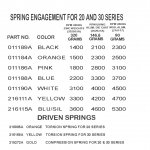pghp8ntballer
New member
Hey everyone, I am new to karts. I understand how the 30 series torque converter driver weights, garter springs, and driven spring changes affect rpm engagement but I want to know what the results of these changes are...
How will it change operation of the kart through hilly/pretty rough terrain?
Is it better to have a higher engagement for these activities or low engagement?
What changes beyond rpm engagement can be expected by switching to cast aluminum driver weights from zinc? Does the engine rev faster, etc?
if larger than stock (+ 3 to 4 inches) diameter tires are in the plans, how would you adjust the torque converter to accommodate for this assuming the stock sprockets are left unchanged?
I'm sorry if the questions aren't clear.
Thanks!
How will it change operation of the kart through hilly/pretty rough terrain?
Is it better to have a higher engagement for these activities or low engagement?
What changes beyond rpm engagement can be expected by switching to cast aluminum driver weights from zinc? Does the engine rev faster, etc?
if larger than stock (+ 3 to 4 inches) diameter tires are in the plans, how would you adjust the torque converter to accommodate for this assuming the stock sprockets are left unchanged?
I'm sorry if the questions aren't clear.
Thanks!


